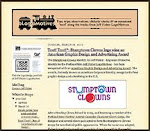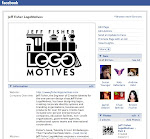It's always interesting to be contacted by a nonprofit organization with a request to design a logo pro bono. I get numerous such requests each month. These days, to give myself permission to politely decline some inquiries, I only consider donating my services if the project is related to education, nonprofit performing arts groups, children's causes, HIV/AIDS or issues in which I have a strong personal interest.
I had certainly heard of the Cat Adoption Team (C.A.T.), the Pacific Northwest’s largest nonprofit, limited admission cat shelter with its own on-site full-service veterinary hospital. My initial contact with the organization came via an email from a graphic designer doing volunteer work for C.A.T. She explained that she was a fan of my own identity design work and asked if I would possibly consider designing a new logo for C.A.T. as it approached its tenth anniversary celebration.

After expressing my interest in taking on the project, an appointment was made with the woman who was the group's Executive Director at the time. I appreciated the advertising and marketing background of this individual. She had a great understanding of branding - and the fact that the logo in use at the time (above left) may have served the agency well in its first decade, but it was time to convey a stronger, more professional and memorable public persona. With the emotional and historical investment in the existing logo, the was certainly a "never tell a potential client their logo sucks" situation. Personally, I felt the hand-drawn logo, with one black cat looking outside a window while another looked in, projected a melancholy and somewhat sinister image.
My hope was to create a simple, memorable logo, that would be appeal to both adults and children, as an identifier for the group. With the gift of an organization name acronym creating the primary word associated with the cause, I set about the design a logo turning C.A.T. into the graphic image of the animal. I got increasingly excited as I doodled (above right) and saw a recognizable cat form taking shape within the name.

My excitement was shared by the Executive Director when I explained the direction in which I was taking the project. As I fine-tuned the concept, I opted to make use of letterforms from the font Frankfurter to form the cat and then be used to spell out the organization name. The roundness of the letters created a soft, friendly, inviting design (above) for review by the client Board of Directors. The Executive Director seemed very pleased by my effort and felt it could successfully take C.A.T. into its second decade with a clever and professional graphic identity.
The Board of Directors did not agree. The Executive Director shared that the board members did not feel the design was "warm and fuzzy enough" to successfully represent the cause. She then graciously offered me an opportunity that no previous client had suggested. Given the fact I had donated my time and invested so much energy, into a design that I was convinced would best serve C.A.T and the Board of Directors disagreed; she was allowing me to remove myself from the situation if I chose to do so.
I accepted her offer to separate myself from the project. Afterwards I learned that other designers had less than successful past business relationships with the agency, too. The combination of a mostly volunteer organization, the historical and emotional attachments to the group's past designs, a voting Board of Directors sometimes becoming a "design by committee' presence, and other elements can make such projects challenging - for the designer and the client.
Soon after ending my participation in the C.A.T. project, I received a call-for-entries for a book to display 50 of the best international rejected, or "killed," design concepts. The C.A.T. logo concept design got a second life when it was accepted for publication in the book Killed Ideas: Vol 1.
The C.A.T. design went on to have more than nine lives beginning with winning a Silver Award in the Summit Creative Awards. It is also featured in the books Letterhead & Logo Design 11, American Graphic Design & Advertising 25, Designing for the Greater Good, LogoLounge Master Library Vol. 2, Logolicious, For a Good Cause (Spain), iheartlogos season one, Logo Design Vol. 3 (Germany), Logo Nest 2 and LogoBook (Spain). The logo also appears in the textbook Perfect Match Art Primary 5, by Prisca Ko Hak Moi - a collaborative project of publisher Pearson Education South Asia and Ministry of Education Singapore. Most recently it is an illustrative element in an article I wrote for the 2011 Artist's and Graphic Designer's Market.
 © Cat Adoption Team
© Cat Adoption TeamWhat became of the need for a Cat Adoption Team logo design? Well, another designer (if I knew the name I would post it here) did take on the project and successfully created an identity for C.A.T. (above). It seems that the organization got their more literal and "warm and fuzzy" feline representation within the logo design. It has been used as the agency's identity for some time now.
I had an immediate critical, rather than personal or bitchy, reaction to the new logo when first seeing it - and other logo designers have emailed me with similar thoughts. With the illustrative cat's head resting on the "C" letterform, that letter seems to visually close creating a noose-like appearance - or the cat's head seems to resting in wait for the falling of a guillotine blade or the ax of a a public executioner. Perhaps not the best graphic message for a "no-kill" cat shelter.
© 2015 Jeff Fisher LogoMotives





